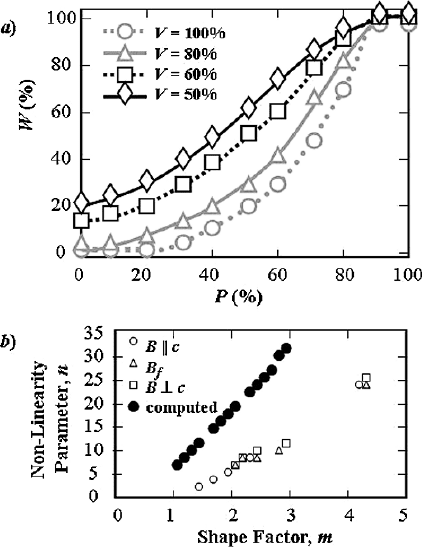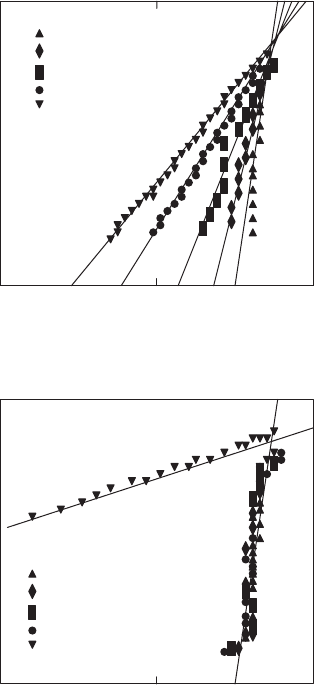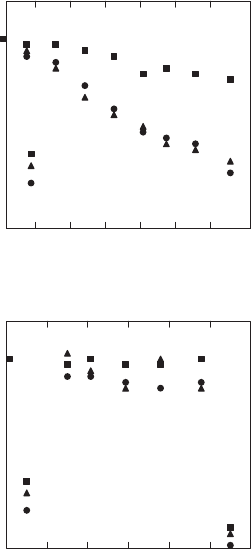Parinov I.A. Microstructure and Properties of High-Temperature Superconductors
Подождите немного. Документ загружается.


10.5 Current Percolation and Pinning of Magnetic Flux in HTSC 473
Fig. 10.25. (a) Change of degree of broken columns (W ) as a function of probability
of the broken links (P ) for system, including V % superconducting elements, and (b)
change of non-linearity parameter, n, as a function of distribution shape factor, m
[784]. The computational results (black circles) are compared with experimental data
(white figures) [875]
Figure 10.25a shows W in dependence on P for M = 400,N = 1000,C =2
and variation of V from 50 to 100%. In the case of V = 100%, the fraction W
of broken columns starts to increase for P>20%, that means a generation
of an electric field. For V = 60%, W has already finite value even for P =0.
After calculation of E–J characteristic, so-called non-linearity parameter, n,
is found. As it is shown in Fig. 10.25b, the dependence of n on m,calculated
in the considered model, has a similarity with the experimental results [875].
Other approach, based on the statistical distribution of critical current
density and used for study of non-linear E–J characteristic, is developed in
[1161]. According to this model, the de-pinning probability function (Q)can
be described as a function of current density (J) by the next expression:
Q(J)=[(J − J
cm
)/J
0
]
m
, (10.40)
where J
cm
is the percolation threshold identical to the minimum value of J
c
; J
0
is the scale parameter, representing half-width of the statistic J
c
distribution;
474 10 Modeling of Electromagnetic and Superconducting Properties of HTSC
and m is the distribution shape parameter. Then, the E–J characteristic can
be obtained integrating Q(J)as
E(J)=ρ
FF
J
0
[(J
c
− J
cm
)/J
0
]
m
dJ
c
, (10.41)
where ρ
FF
is the resistivity for the uniform flux flow [1161]. In particular,
this model has permitted to estimate influence of bending strain on transport
E–J characteristics for Bi-2223 Ag/AgMg-alloy-sheathed tape [549]. More-
over, this approach permits to separate the components, caused by the grain
connectivity and flux pinning, originated from the bending strain.
10.5.4 Aging at Mechanical Loading
In design of energetic HTSC cables, an estimation of electric properties of
the current-carrying elements presents the significant interest at mechanical
aging of the sample, that is, at long cyclic and static loads. A probabilistic
approach is one of the main methods for the solution of this problem [719,
720]. The V –I characteristic can be described, using the Weibull’s distribu-
tion, and the time behavior of the relevant parameters can be considered
during mechanical aging of the cable material, for example, under tensile
stress and bend-vibration. In order to model the sample behavior, a proba-
bility function, g(J
c
), is introduced, which describes the probability that a
cross-section of a superconductor has a given value of the critical current den-
sity, J
c
[67]. It has been shown that g(J
c
) could be analytically derived as
the second derivative of the E–J characteristic via flux-flow resistivity. This
relationship holds, however, for a pure superconductor of type II, that is,
neglecting effects of any non-superconducting matrix. Determination of second
derivative of E–J characteristic can be found numerically [1135]. A best-fitting
distribution must be chosen in order to obtain parameters, which are able to
describe the function g(J
c
), as well as its integral, that corresponds to the cu-
mulative probability, G(J
c
). The probability function considered below is the
two-parametric Weibull’s distribution, which fits both skewed and unskewed
probability density characteristics. The expressions of the two-parametric den-
sity and cumulative-probability Weibull’s function are found by [527]
F (x)=1− exp[−(x/α)
β
]; (10.42)
f(x)=(β/α)(x/α)
β−1
exp[−(x/α)
β
], (10.43)
where α and β are scale and shape parameters, whereas the random variable
x corresponds to the critical current density J
c
.
The Weibull’s parameters can be estimated in several ways [112]. In par-
ticular, they can be calculated on the base of test data, obtained by the prime
derivative of the E–J characteristic, that is, G(J
c
), numerically performed

10.5 Current Percolation and Pinning of Magnetic Flux in HTSC 475
and plotted in the coordinate system lg{−ln[1 − F (x)]} in dependence on
lg(x), which linearizes (10.42), transforming it into a straight line of slope β.
Actually, this probabilistic approach should be only applied to data rel-
evant to the superconductor, while the tested samples have a silver shield,
whose contribution is not easily separable from that of the superconductor
body. Therefore, the Weibull’s function can be used only to the experimen-
tally obtained V –I characteristics with the aim to show how it is correlated
with mechanical stress aging.
Examples of V –I characteristics, measured in aged and unaged specimens
are shown in Fig. 10.26 for vibrated and tensile-stressed samples. The silver
shield V –I characteristic is also presented in Fig. 10.26 for the sake of compar-
ison. As it is followed from this, the mechanical aging process can significantly
affect V –I characteristics. Moreover, the V –I curves tend to the silver resis-
tance for values of currents monotonously decreasing as aging time increases.
−
−
−
−
−
1200
1000
800
600
400
200
0
−
−
−
−
−
0 min
80 min
160 min
240 min
320 min
Ag
Current (A)
Voltage (μV)
(a)
2500
2000
−
1500
−
1000
−
500
−
0
0
−
−
−
−
0 min
139 min
248 min
379 min
540 min
Ag
Current (A)
Voltage (μV)
0
70605040302010
70605040302010
(b)
Fig. 10.26. V –I characteristics at various aging time for cases of vibration aging
(a) and tensile-stress aging (b) [720]

476 10 Modeling of Electromagnetic and Superconducting Properties of HTSC
Tensile stress and vibration do age specimens in a different way. While
the former creates local damage cracks only, the latter leads to overall degra-
dation, when silver shield is no more able to endure the applied stress. This
approach permits to obtain the Weibull’s functions for cases of cyclic and ten-
sile loads (see Fig. 10.27 [720]) with the normalization factor, defined by the
silver characteristics. Moreover, the scale and shape parameters (α, β)ofthe
Weibull’s distribution can also be estimated and plotted as a function of aging
time (see Fig. 10.28 [720]). Figures 10.26–10.28 permit to estimate effects of
the aging level and type on electrical properties of superconductor. So, the
−
−
−
−
−
−
−
−
−
99.9
95
90
70
50
30
20
10
1
0
−
−
−
−
−
−
−
−
−
Current (A)
Probability (%)
0 min
80 min
160 min
240 min
320 min
(a)
(b)
−
−
−
−
−
−
−
−
−
99.9
95
90
70
50
30
20
10
1
0
1 100
−
−
−
−
−
−
−
−
−
Current (A)
Probability (%)
0 min
139 min
248 min
379 min
540 min
1 10010
10
Fig. 10.27. Weibull’s plots derived from normalized prime derivative at different
aging times for cases of vibration aging (a) and tensile-stress aging (b)

10.5 Current Percolation and Pinning of Magnetic Flux in HTSC 477
−
−
−
−
−
α
β
J
c
1.2
1.0
0.8
0.6
0.4
0.2
0.0
α
/
α
0
β/β
0
J
c
/J
c0
α/α
0
β/β
0
J
c
/J
c0
−
−
−
−
−
1.2
1.0
0.8
0.6
0.4
0.2
0.0
α
β
J
c
−
−
−
−
−
(a)
(b)
−
−
−
−
−
Time (min)
0 350300250200150
100
50
Time (h)
0 600500400300200100
Fig. 10.28. Relative values of scale (α)andshape(β) parameters of the Weibull’s
distribution and also of critical current density (J
c
)vstime(t), for one sample in
the case of aging due to vibration (a) and tensile stress (b)
critical current (I
c
) at moderately high and low cumulative probability signif-
icantly decreases as aging time increases, sharply in the case of tensile stress,
progressively for vibration. Similarly, the value of β significantly diminishes
with time, reaching the lowest values for the most aged samples.
10.5.5 Effective Electrical Conductivity
of Superconducting Oxide Systems
Finally, based on the percolation theory, we consider current carrying in the
model HTSC systems of YBCO and BSCCO, investigated in Chap. 8, and
also study corresponding effective characteristics. Comparison of the results
of fracture resistance alteration due to action of different toughening mecha-
nisms, with qualitative features of electrical conductivity, stated in this section

478 10 Modeling of Electromagnetic and Superconducting Properties of HTSC
permits to estimate an effect (positive or negative) of microstructure features
on properties of the considered superconductors.
YBCO Ceramic
It is known that electrical conductivity (the inverse value of resistivity) in
non-ordered media is proportional to the self-diffusion factor, and hence, the
average quadratic deviation of the liquid particles in absence of an external
force [332]. Following [800], consider the YBCO model structure as a perco-
lating cluster with cells, occupied by grains, and by free cells, corresponding
to voids. Obviously, the percolating (or conducting) properties decrease due
to the existence of intergranular microcracks and porosity. However, it is also
clear that all model structures considered below, stated in Chap. 8, possess a
joining, percolating cluster, because the following inequality always fulfills:
C
p
+ f
b
<< p
c
, (10.44)
where C
p
= N
p
/N is the closed porosity of the ceramics (N
p
is the cell number,
occupied by voids and N is the total cell number); f
b
= l
g
/l
l
is the ratio of
the cracked facets to the total number of boundaries between cells of the
joining cluster (obviously, f
b
<f
m
= l
g
/l
i
,wherel
i
is the total length of the
intergranular boundaries, because l
i
<l
l
); and p
c
=0.5927 is the percolation
threshold for a square lattice.
5
In order to estimate effective electrical conductivity of the model struc-
tures (considered in Sect. 8.1.1 and 8.1.2), we modify a known algorithm,
called ant into maze, applied for diffusion description in irregular media [332].
Take into account together with crystallite phase and voids, an existence of
grain boundary microcracks, and also GBs, possessing a smaller conductivity
compared to intracrystalline space. Consider a chance movement on only oc-
cupied cells (on crystallite phase) of the percolating cluster. At any time, the
probable numbers, p
k
∈ [0, 1] (where k =1,...,4) are generated in all cells,
which are adjacent to the main cell. In the case, when the cell under consid-
eration is separated from the main cell by a GB then its probable number is
decreased by 0.1 (to design the predominant cluster growth within a grain). If
an intergranular boundary has been replaced by a microcrack or the adjacent
cell is a void, then the corresponding probable number is found to be zero.
The cluster growth results from the occupation of a cell with largest possible
number, p
k
≥ p
c
. The cluster growth is impossible when the initial cell is
surrounded by voids, microcracks or when all of p
k
<p
c
. Next, all the process
is repeated. At each step, including a marking time, the value of t increases
by 1. In the time, t = 0, some chance cell of the joining cluster begins to
5
Similar modeling can be fulfilled at other regular lattices having the following
values of the percolation threshold, p
c
, and the shape of unit cell [1075]: 0.6970
(hexagon), 0.5 (triangle), 0.4299 (diamond), 0.3116 (cube), 0.2464 (b.c.c.), and
0.1980 (f.c.c.).

10.5 Current Percolation and Pinning of Magnetic Flux in HTSC 479
0.58
0.26
0.43
(0.33)
0.75
(0.65)
0.00
0.18
(0.08)
0.00 0.00
0.94
0.71
(0.61)
0.32
(0.22)
0.46
0.66
(0.56)
0.53
0.00
0.80
(a)
(c)
(b)
(d)
0.00
Fig. 10.29. An example of percolating cluster growing in YBCO ceramic. Numbers
denote probabilities of cell occupation (in brackets there are considered probabilities,
taking into account a priority, which are compared with percolation threshold, p
c
=
0.5927). A cross corresponds to the cluster cell at previous step. Microcracks, formed
during cooling, are shown at GBs; porosity is denoted by gray color
move. In time t, the square of distance between initial and final sites is calcu-
lated. Then, the modeling is repeated several times, and the mean quadratic
displacement, R, associated with the conductivity of the modeled structure is
calculated. An example of the cluster growth is shown in Fig. 10.29.
Statistically reliable results are obtained by applying the stereological ap-
proach. We obtain, again a necessary number of realizations for the statistical
process to find unskewed estimation of the considered stereological character-
istic as [145]
n = (200/y)(σ
x
/x) , (10.45)
where y is the accuracy level (in this case 10%); σ
x
is the variance; x is the
mean value of the stereological characteristic. At the study of the electric con-
ductivity process, first a growth of a joining cluster on the type of occupying
percolation [332] in two-dimensional lattice (25 × 40 cells), forming a path
from left to right of its boundary, is considered. As
x, we select the lattice
width (= 40), and the value of σ
x
is calculated by corresponding exceeding of
the cluster cell number over lattice width.
The percolation properties of the model microstructures, estimated for
t = 100, are presented in Table 10.1. The normalized mean quadratic dis-
placement, R/R
0
(where R
0
is the corresponding value for non-porous mate-
rial), which is proportional to electrical conductivity decreases with growth
of initial porosity as well as the square (cell number) of the joining cluster,
S/S
0
(S
0
is the cluster area for nonporous material). These data correlate
with increasing GBs, l
i
/l
l
, at the enhancement of the initial porosity, C
0
p
,
and decreasing of mean grain size, obtained in [814]. Thus, introducing even
small priority for growth of the joining cluster within grain compared to its

480 10 Modeling of Electromagnetic and Superconducting Properties of HTSC
Table 10.1. Some model parameters for YBCO ceramics of various structures
Properties C
0
p
=0% C
0
p
= 20% C
0
p
= 40% C
0
p
= 60%
l
i
/l
l
0.503 0.523 0.557 0.630
S/S
0
1.000 0.956 0.872 0.644
R/R
0
1.000 0.866 0.846 0.785
propagation in adjacent one (in this case, it corresponds to enhancement of
probability by 0.1) correlates with experimental data and leads to qualita-
tive confirmation of known results by the results of computer simulation. The
presented results point again an important role of GBs and need to obtain
coarse-granular YBCO structures. More accuracy estimations can be obtained
in the framework of this model under condition of quantitative description of
the difference of conductive properties in grain and through GB. Obviously,
they will depend on features of domain structure of single crystallites, GBs
continuity, secondary phases and so on.
Large-Grain Melt-Processed YBCO
Taking into account the model structures of the melt-textured large-grain
YBCO samples, investigated in Sect. 8.3, it is obvious that their transport
properties are found by the existence of non-superconducting (211) and su-
perconducting (123) phases, and also by GBs. Then, in the electrical conduc-
tivity model, presented in the previous section, only one position is added,
namely in the case of the adjacent cell occupation by the 211 particle, the
probable number is replaced by zero. An example of the cluster growth is
shown in Fig. 10.30, but the obtained numerical results are presented in
Table 10.2 [822].
A comparison of the obtained effective characteristics with the model re-
sults of Sect. 8.3 (see Table 8.7) shows a correlation between the mean pinned
grain area,
S, superconducting field per grain, S
SR
and ratio of the total inter-
granular boundary length to the total number of GBs between cells of joining
cluster, l
i
/l
l
, on one hand, and change of the seed area, on the other hand.
The percolation properties have been calculated for t = 100. The behav-
ior of the mean quadratic displacement, R/R
0
, and the joining cluster area,
S/S
0
(where R
0
and S
0
are the corresponding values for the case, f =0.0and
Table 10.2. Numerical results
Property f =0.0,
S
S
≈ 2S
m
0
f =0.0,
S
S
≈ 3S
m
0
f =0.1,
S
S
=0
f =0.1,
S
S
≈ 2S
m
0
f =0.1,
S
S
≈ 3S
m
0
f =0.2,
S
S
=0
f =0.2,
S
S
≈ 2S
m
0
f =0.2,
S
S
≈ 3S
m
0
l
i
/l
l
0.325 0.235 0.133 0.116 0.111 0.136 0.099 0.083
R/R
0
0.803 1.000 0.649 0.816 0.865 0.452 0.473 0.544
S/S
0
0.979 1.000 0.929 0.957 0.979 0.893 0.900 0.921

10.5 Current Percolation and Pinning of Magnetic Flux in HTSC 481
0.30
0.95
(0.85)
0.69
0.00
0.66
(0.56)
0.18
(0.08)
0.39
(0.29)
0.78
(0.68)
0.59
(0.49)
0.24
(0.14)
(a) (b)
(c)
0.52
0.73
Fig. 10.30. An example of percolating cluster growing in large-grain YBCO sample.
Numbers denote probabilities of cell occupation (in brackets there are considered
probabilities, taking into account a priority). A cross corresponds to the cluster cell
at previous step. Gray color shows 211 particle
S
S
≈ 3S
m
0
), as well as the change in the value of S
SR
coincide with experimen-
tal data [318, 640]. We confirm that YBCO conducting properties decrease
with increase in the fraction of the 211 normal particles and with decrease in
the seed. At the same time, the considered toughening mechanisms intensify
(that in turn, influences indirectly an increasing of current-carrying proper-
ties) with an increase of the 211 normal particle size and fraction into 123
superconducting matrix. Finally, note that for completeness of investigation
of the percolation properties in this case, it is necessary to take into account
the GB microcracking during cooling and misorientaion of grain boundaries,
which are caused by indirect effects of dispersed phase and also contribute in
final superconducting properties.
Effect of Microstructure Dissimilitude
The transport properties of the YBCO model structures, considered in
Sect. 8.4, are caused by superconducting granular phase, voids, microcracks
and GBs. Again, based on the algorithm ant into maze [332], effective char-
acteristics can be calculated, which are presented in Table 10.3 [819]. An
example of the cluster growth is shown in Fig. 10.31.
The numerical results show a correlation between the grain area and the
ratio of total intergranular boundary length to total number of boundaries
between cells of the joining cluster, l
i
/l
l
. The percolation properties have

482 10 Modeling of Electromagnetic and Superconducting Properties of HTSC
Table 10.3. Numerical results
ν,
◦
C/h l
i
/l
l
R/R
0
S/S
0
10 0.51 1.00 1.00
20 0.50 0.91 0.87
30 0.39 0.81 0.74
been calculated for t = 100. The behavior of the mean quadratic displace-
ment, R/R
0
, and the joining cluster square, S/S
0
(where R
0
and S
0
are the
corresponding values for the case ν =10
◦
C/h), as well as a change of the value
of l
i
/l
l
coincide with test data [642]. Thus, it is confirmed that YBCO super-
conducting properties diminish with increased heating rate. This corresponds
also to the trends in the changes of the specific fracture energy (γ
(1)
F
/γ
(0)
F
)and
the microstructure dissimilitude (ΔK
Ic
/ΔK
c
), following from Fig. 8.33.
BSCCO Bulks
Considering the Bi-2223 model structure as percolating cluster with cells,
occupied by grains, note that the percolation properties are found in this
case by GBs, microcracks and texture, describing a connectivity of adjacent
Fig. 10.31. An example of propagation of percolating cluster in the case of
microstructure dissimilitude. Numbers denote probabilities of cell occupation
(in brackets there are considered probabilities). A cross corresponds to the clus-
ter cell at previous step. Gray color shows voids; microcracks are presented at GBs
